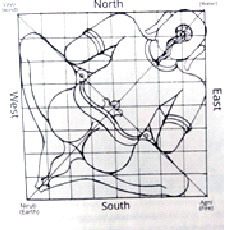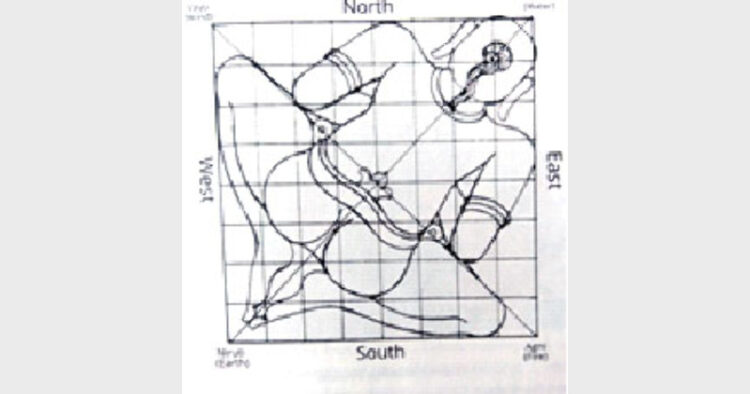The complexity of information on temple design and construction is simplified and decodified in Vastupurush Mandal’s figure to make temple construction easy for masses
-Dr Ujwala Chakradeo

The Vastupurush Mandal is like an appliance. It has ‘yantra’, ‘mantra’ and ‘tantra’ all in one. It also has guidelines for following appropriate proportions of architecture, design guidelines and details of building construction. (Sort of an encyclopaedia or data book for temple design and construction).
The draft copy of ‘La Modular’ written by Le Corbusier, noted he gave French architect of the twentieth century to renowned scientist Einstein for review and comments. After reading the copy, Einstein’s reply was, ‘you have made ugly difficult and beautiful easy’. So apt a description. Vastupurush Mandal and its norms made it easy to create beautiful and proportionate temple construction easy for the general public.
Machine-?????
The device. It is the composition of geometrical shapes in particular proportions. Certain shapes have a definite effect on the human body and mind. The triangle and square are considered to be basic or original shapes. The Vastupurush Mandal was designed on the basis of the study of the effect of the inner space of the Vastu and its outer form on the latent mind of a human being.
Spell- ?????
The effect of mantras, chanting of mantras, and mantras’ rhythm also affect the human mind and the human body. If mantras are uttered in a certain way, they can strike at prescribed energy centres (chakras) of the human body, activating them for the desired results.
Mechanism- ?????
The technique is the art of doing a job in a certain way. One has to be aware of the technique to acquire it. Techniques can be taught and gained. The skill of construction techniques can be attained. The technique to design a building needs to be assimilated.
To facilitate the coordination of all the elements mentioned above, Vastupurush Mandal was designed. A most wonderful creation of our ancestors, which has retained its relevance for all these years and even today. This Mandal is not the plan nor the form of any particular temple. Many questions like how to design a temple, where to start, on what day the construction activity can be started, how to check the soil, how to dig the foundation, how deep to dig, how to build, what to carve on it, which sculpture should come in which direction, how to orient the temple entrance are faced at the time of construction. Vastu Shastra answers all and many such questions. Vastupurush Mandal decodes this information and makes it simple for implementation.
In spite of this simplification, intervention and supervision of Sthapati-an architect was always needed. Qualities and qualifications of Sthapati are given in detail in Vastu Shastra. Formal architecture education can be reframed based on this information.
(The columnist is Principal of SMM College of Architecture, Nagpur and specialises in Bharatiya Architectural Heritage)













Comments